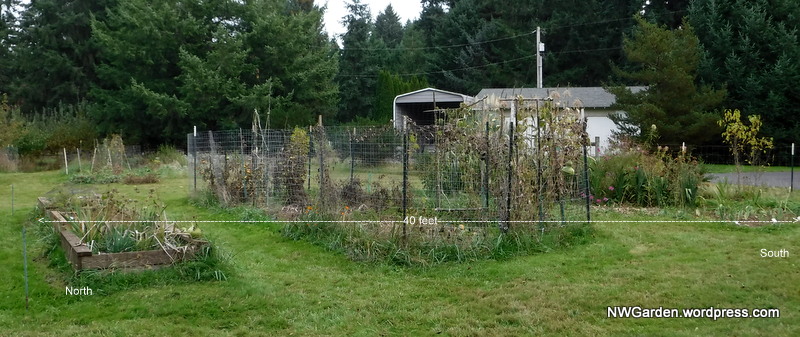Given that I have some regrets about my prior garden and orchard planning, or lack of planning, I am being more careful this time. I need to create a more accessible garden and orchard, this time around, which will be fenced against herbivores. The fencing will be expensive, and not perfect, but we will see. The fenced area will be 35 feet by 40 feet, with seven foot tall fence.
First, this is the existing area. The fencing is make shift, where I had tomatoes and squashes, and some beans, this year. Prior rotations were sweetcorn, potatoes, squashes, and annual flowers. The grass paths will become garden. I will use wooden planks for paths.
I have estimates for the fencing. I should be able to decide on a fencing contractor next week.
Here is my plan so far. This is sort of how I planned kitchen and bathroom remodels, with cut-outs roughly to scale so I can move them around. I lined up 7 quarters, each of which represents 5 foot diameter circle. That makes 35 feet. Then I took our one from each row, to give myself space for walking and working. I chose 5 foot diameter because I measured my 18 year old Liberty, on M27, and it is just under 5 feet diameter. The pennies represent about 3 feet diameter, for columnar trees.

I won’t buy many trees. Instead, I want to use cultivars that grow well for me already, but are on taller trees. I ordered Bud-9 rootstock for most, and Geneva 222 for the less vigorous cultivars. My list will probably evolve, but so far I think it’s:
On Bud - 9
Porter - a heritage yellow apple that does very nice in my yard.
Pristine - a modern, early, disease resistant, very delicious yellow apple.
Liberty - our favorite, and disease resistant. Midseason apple.
Cosmic Crisp - this will be on M27, that’s the choice I have ordering it.
Gravenstein - another favorite, early, vigorous.
Winecrisp - a modern, disease resistant apple, similar to Liberty, Mid season.
Summerred - maybe. Not very productive but I love the flavor.
Akane - early to mid season, very tasty. or I might just keep the original tree.
Macoun - I haven’t tried it yet, ordered scion. It has such good reviews.
On Geneva 222
Honeycrisp - Maybe. I love the apple but the vigor is so poor and I’m not sure about disease susceptibility.
Jonared. Does well for me here, a sentimental favorite.
Rubinette. Mid to late, very tasty.
Queen Cox. Mid to late, very tasty.
Beni Shogun Fuji. Has never born for me but I like an occasional Fuji.
This is 14 cultivars, but I’m only setting aside 12 spaces. I might leave out Summerred and Winecrisp, or keep them on their original semidwarf trees. Ditto for Akane, although that one is too tall for me now. I might want to include Airlie Redflesh, but that means not including one of these others. Airlie does get some scab, so I’m not sure.
The dimes are columnar cultivars. I like Northpole so may grow two. I’ll also have Scarlet Sentinel and Golden Sentinel, all of these on Bud 9. I may move in my one-year-old Tasty Red and Golden Treat, but these are on more vigorous rootstock, which I don’t want. I also don’t know what they taste like yet, so may keep them in my other fenced mini-orchard.
This does not leave room for the experiments I’m planning for a couple of pears on weird rootstocks like serviceberry or aronia or on Bud-9 with Winter Banana interstem. Maybe that’s the dimes.
It will take several years for these to reach bearing size. Meanwhile, I can grown some small annual veggies between them, such as bush beans. The fencing should keep rabbits out too.
Herbivores stay away from sweetcorn, potatoes, swiss chard, turnips and some of the squashes, so those will remain outside the fencing.
After getting the fence up, the next step is clearing the current vegetable garden and prepping the lawn areas. I’ll cover the lawn areas with black plastic for the winter, which worked nicely before. Or I might let the chickens and ducks work on it for a while. Step three will be making the bench grafts this winter. I might keep them in containers for a year, I’m not decide on that yet.
This is a long term plan. I’ll keep most of my fruit trees as is until these produce, but by miniaturizing at lease the apples, and maybe a few others, I hope to have a more accessible garden for me to work in where I can dote on these trees. This may be a place for a Morus nigra, and for a Babycakes blackberrry (maybe the dimes) a well.
’
